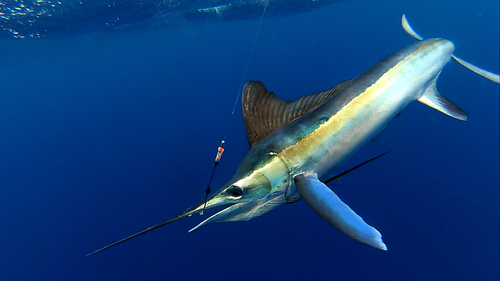
White Marlin
The Atlantic bluefin tuna (Thunnus thynnus) is a magnificent and highly migratory species of tuna found throughout the Atlantic Ocean. Renowned for its size, speed, and commercial value, this powerful fish plays a crucial role in the marine ecosystem. However, its desirability has led to significant conservation challenges.
15 30 years
Lifespan
280 - 300 cm
Length
Vulnerable
Conservation Status
80 km/h
Swimming speed
Carnivorous
Diet
Highly Migratory, Pelagic Migration
Migration
Appearance Overview
The Atlantic bluefin tuna is a large, torpedo-shaped fish with a streamlined body built for speed and endurance.
Coloration
Dark metallic blue above and silvery white below, providing camouflage from above and below.
Fins
Two dorsal fins, the first depressible; small, yellow finlets run down the back and belly towards the tail.
Body Shape
Torpedo-shaped and streamlined, allowing for efficient movement through water.
Length
Typically up to 10 feet (3 meters), but can reach up to 13 feet (4 meters).
Weight
Commonly up to 550 lbs (250 kg), but can reach over 1,500 lbs (680 kg).
Diet
Carnivorous, feeding on a variety of fish, squid, crustaceans, and eels. They are opportunistic predators.
Feeding Behavior
Atlantic bluefin tuna are powerful and fast swimmers, often hunting in coordinated schools to herd and capture prey. They can dive to considerable depths to feed.
Social Behavior
Highly migratory, forming large schools, especially during spawning season. They exhibit complex social behaviors, including cooperative hunting.
Commercial Relevance
Extremely high value, particularly in sushi and sashimi markets, where its fatty flesh is considered a delicacy. This demand drives high prices and intense fishing pressure.
Conservation measures
International fishing quotas, mandatory catch reporting, minimum size limits, and time-area closures. Some regions also implement tagging programs to monitor populations.
Status
Endangered (Varies by subpopulation; some stocks are recovering, while others remain depleted).
Threats
Overfishing (historically and ongoing), illegal and unreported fishing, bycatch in other fisheries, and climate change affecting their prey distribution and spawning habitats.
Habitat Distribution
Depth Range
0-1,000 meters (0-3,280 feet), but most commonly found in the upper few hundred meters.
Geographic Range
Widely distributed across the Atlantic Ocean, from the Gulf of Mexico and the Mediterranean Sea to the waters off Norway and Canada.
Preferred Environment
Temperate and subtropical waters; pelagic, meaning they live in the open ocean rather than near the seabed.
Reproduction and Life Cycle
Breeding Habits
Spawns in warm waters, primarily in the Mediterranean Sea and the Gulf of Mexico. Spawning occurs in large aggregations, with females releasing eggs and males releasing sperm into the water column.
Development Stages
Eggs hatch into larvae, which drift as plankton. Juveniles grow rapidly, feeding on smaller organisms. They gradually develop into mature adults, capable of long migrations.
Fecundity
Females are highly fecund, capable of producing up to 30 million eggs per spawning season, depending on their size and condition.
Maturity Age
Reaches sexual maturity relatively late, typically between 4-8 years, although this can vary by population and environmental conditions.
Faqs about White Marlin
Do Atlantic bluefin tuna migrate?
Atlantic bluefin tuna are highly migratory, traveling vast distances across the Atlantic Ocean. They have specific breeding grounds, such as the Mediterranean Sea and the Gulf of Mexico.
Are Atlantic bluefin tuna warm-blooded?
Yes, they are warm-blooded, maintaining a body temperature higher than the surrounding water, which allows for greater muscle efficiency and power.
How long do Atlantic bluefin tuna live?
They can live up to 40 years, although the average lifespan is often shorter due to fishing pressure.
How fast can Atlantic bluefin tuna swim?
Atlantic bluefin tuna are among the fastest fish in the ocean, capable of reaching speeds up to 43 mph (70 km/h) in short bursts.
Why are Atlantic bluefin tuna endangered?
The high demand for their meat, especially in sushi and sashimi markets, has led to overfishing and significant population declines. Their slow growth and late maturity also make them vulnerable.
Is fishing for Atlantic bluefin tuna regulated?
Yes, regulations are in place, including strict fishing quotas, size limits, and seasonal closures, managed by international organizations like ICCAT (International Commission for the Conservation of Atlantic Tunas).
Copyright @ Nature Style Limited. All Rights Reserved.
 English
English